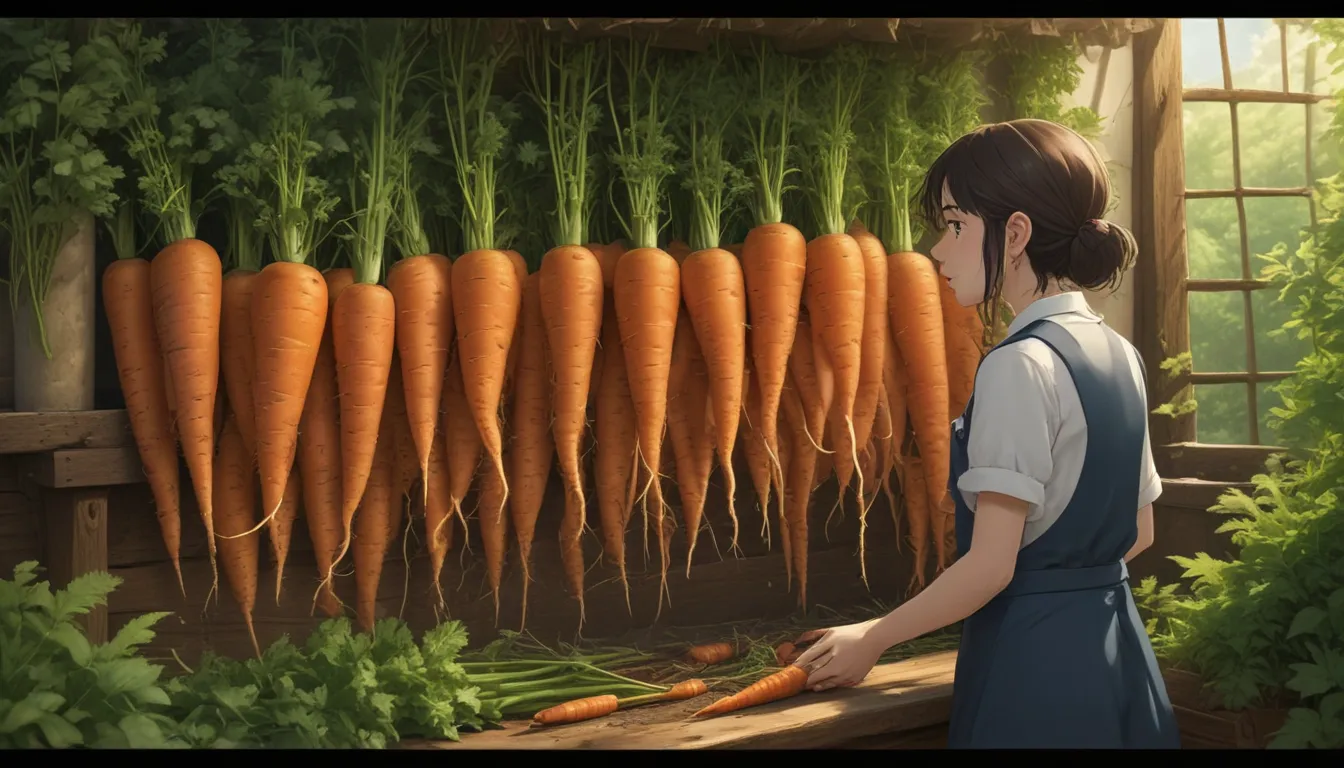A Deep Dive into Growing Danvers Carrots: Tips and Tricks

Have you ever struggled to grow carrots in your heavy soil garden? Are you looking for a reliable variety that can thrive in challenging conditions? If so, Danvers Carrots might be the solution you’ve been searching for.
In this comprehensive guide, we’ll explore everything you need to know about growing Danvers Carrots, from planting to harvesting to cooking. Let’s dive in and discover how you can become a master carrot grower, even with tough soil conditions!
The Mighty Danvers Carrot
Originating from Danvers, Massachusetts, Danvers Carrots have a rich history of cultivation that spans over a century. Introduced by growers from Danvers, this variety is known for its ability to thrive in rocky or heavy soils, producing medium-sized carrots with a deep, rich orange color.
In 1947, an improved version called ‘Danvers 126’ was released, boasting a sweeter flavor, increased crack resistance, and better yields. Today, Danvers Carrots not only excel in challenging soil conditions but also offer exceptional taste, enhanced fiber content, and excellent storage capabilities.
What You’ll Learn
- What Is a Danvers Carrot?
- How to Sow
- How to Grow
- Growing Tips
- Where to Buy Seeds
- Managing Pests and Disease
- Harvesting
- Storage
- Preserving
- Recipes and Cooking Tips
- Quick Reference Growing Guide
What Is a Danvers Carrot?
All strains of Daucus carota, including Danvers Carrots, originated from central Asia. These biennial plants store sugar in their central taproot during the first season, providing energy reserves for flowering in the second season. However, in our gardens, we harvest these tasty taproots before their second year.
Danvers Carrots are notable for their ability to grow in heavy soils, reaching a mature length of seven or eight inches. They feature conical shapes, with diameters ranging from one and a half to two inches. Additionally, Danvers Carrots have sturdy stalks that facilitate easy harvesting.
How to Sow
When planting Danvers Carrot seeds, consider essential factors like sunlight, soil depth, and pH levels. These root vegetables thrive in full sun and require cultivation in soil at least 10 inches deep to accommodate their mature roots.
For optimal growth, plant Danvers Carrots in loam or sandy soil, enriched with composted organic matter. A slightly acidic soil pH of 6.0 to 6.8 is ideal for these carrots. Ensure the soil remains moist throughout the germination period, which can last between 14 to 24 days.
Sow seeds about 14 to 28 days before your average last frost date, ensuring they are spaced an inch apart in rows separated by six inches. After planting, maintain consistent soil moisture to support seed germination.
How to Grow
To promote healthy growth and abundant harvests, provide Danvers Carrots with sufficient water, thinning seedlings to two inches apart once they reach a few inches tall. Implement weed control measures to prevent competition for nutrients and moisture, which could cause roots to become woody or stringy.
Maintaining adequate spacing, weed management, and watering will enhance the flavor and yield of your Danvers Carrots. For a more detailed guide on growing techniques, refer to our complete growing tips section.
Growing Tips
- Thin to two inches apart when seedlings are a couple of inches tall.
- Keep weeds at bay with a thin layer of mulch once seedlings reach their final spacing.
- Provide an inch of water per week in warm weather if there is no rainfall.
Where to Buy Seeds
If you’re interested in growing Danvers Carrots, you can find seeds available in various quantities from reputable sellers like Eden Brothers and Botanical Interests. Given the substantial roots of Danvers Carrots, transplants are not recommended, making seeds the preferred option for cultivation.
Managing Pests and Disease
Protecting your Danvers Carrot crop from underground pests like carrot rust flies, carrot weevils, and wireworms is essential to ensure a successful harvest. Deploying floating row covers during sprouting can prevent pest infestations and maintain the integrity of your roots.
Above-ground pests such as aster leafhoppers and flea beetles can also pose a threat to your crop. Additionally, various diseases like Alternaria leaf blight and bacterial soft rot can impact carrot plants. Implementing preventative measures and practicing crop rotation can help mitigate these risks.
Harvesting
Monitor the maturity of your Danvers Carrots, which typically reach full size between 65 to 75 days when planted in spring. Harvest carrots when they exhibit an inch and a half diameter crown above the soil. Follow proper harvesting techniques to ensure you extract mature, sweet roots.
For detailed instructions on harvesting techniques and timelines, explore our comprehensive guide on harvesting Danvers Carrots and other carrot varieties.
Storage
After harvesting your Danvers Carrots, prepare them for storage by removing leaves and storing them in a cool, moist environment. Store the carrots at 32 to 40°F with 95 percent relative humidity to extend their shelf life. Proper storage techniques will ensure your homegrown carrots remain fresh for an extended period.
Preserving
For individuals looking to preserve their Danvers Carrot harvest, consider techniques like fermenting or pickling. Experiment with recipes like Habanero-Carrot Butter to create flavorful and versatile carrot preserves. By incorporating homegrown carrots into innovative recipes, you can explore a range of culinary possibilities.
Recipes and Cooking Tips
Homegrown Danvers Carrots offer a delightful flavor and texture that can elevate various dishes. Whether consumed raw in salads, grilled in roasts, or spiralized into zoodles, Danvers Carrots are a versatile ingredient that can enhance your culinary creations.
Explore innovative recipes such as Instant Pot cooked carrots or slow cooker chicken pot pie to incorporate your homegrown Danvers Carrots into delectable dishes. By mastering various cooking techniques and experimenting with recipes, you can savor the delicious taste and nutritional benefits of your homegrown produce.
Quick Reference Growing Guide
- Plant Type: Biennial root vegetable
- Water Needs: Medium
- Native to: Eurasia
- Hardiness (USDA Zone): 3-10
- Soil Type: Sand or loam
- Season: Spring, fall
- Soil pH: 6.0-6.8
- Exposure: Full sun
- Soil Drainage: Well-draining
- Time to Maturity: 65-75 days (spring); 75-90 days (fall)
- Companion Planting: Caraway, calendula, chamomile, chives, flax, leeks, lettuce, love-in-a-mist, marigold, onions, peas, peppers, radishes, rosemary, sage, wormwood
- Spacing: 2 inches
- Avoid Planting With: Anise, dill, parsley, parsnips, potatoes
- Planting Depth: 1/4-1/2 inches
- Family: Apiaceae
- Height: 7-8 inches
- Genus: Daucus
- Spread: 1-2 inches
- Species: Carota sativus
- Cultivar: Danvers
Incorporating Danvers Carrots into your vegetable garden can provide a rewarding gardening experience and a bountiful harvest of fresh, flavorful carrots. By following the guidelines outlined in this comprehensive guide, you can cultivate robust, tasty carrots in challenging soil conditions while exploring a range of culinary possibilities.
As you embark on your Danvers Carrot growing journey, share your favorite varieties and gardening experiences in the comments below. We look forward to hearing from fellow carrot enthusiasts as we continue to explore the world of homegrown produce. Happy gardening and happy cooking!





